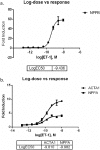RNA expression profiling of human iPSC-derived cardiomyocytes in a cardiac hypertrophy model
- PMID: 25255322
- PMCID: PMC4177883
- DOI: 10.1371/journal.pone.0108051
RNA expression profiling of human iPSC-derived cardiomyocytes in a cardiac hypertrophy model
Abstract
Cardiac hypertrophy is an independent risk factor for cardiovascular disease and heart failure. There is increasing evidence that microRNAs (miRNAs) play an important role in the regulation of messenger RNA (mRNA) and the pathogenesis of various cardiovascular diseases. However, the ability to comprehensively study cardiac hypertrophy on a gene regulatory level is impacted by the limited availability of human cardiomyocytes. Human induced pluripotent stem cell-derived cardiomyocytes (hiPSC-CMs) offer the opportunity for disease modeling. Here we utilize a previously established in vitro model of cardiac hypertrophy to interrogate the regulatory mechanism associated with the cardiac disease process. We perform miRNA sequencing and mRNA expression analysis on endothelin 1 (ET-1) stimulated hiPSC-CMs to describe associated RNA expression profiles. MicroRNA sequencing revealed over 250 known and 34 predicted novel miRNAs to be differentially expressed between ET-1 stimulated and unstimulated control hiPSC-CMs. Messenger RNA expression analysis identified 731 probe sets with significant differential expression. Computational target prediction on significant differentially expressed miRNAs and mRNAs identified nearly 2000 target pairs. A principal component analysis approach comparing the in vitro data with human myocardial biopsies detected overlapping expression changes between the in vitro samples and myocardial biopsies with Left Ventricular Hypertrophy. These results provide further insights into the complex RNA regulatory mechanism associated with cardiac hypertrophy.
Conflict of interest statement
Figures





References
-
- Devereux RB, Roman MJ (1999) Left ventricular hypertrophy in hypertension: stimuli, patterns, and consequences. Hypertension research: official journal of the Japanese Society of Hypertension 22: 1–9. - PubMed
-
- Devereux RB, Wachtell K, Gerdts E, Boman K, Nieminen MS, et al. (2004) Prognostic significance of left ventricular mass change during treatment of hypertension. JAMA 292: 2350–2356. - PubMed
-
- Okin PM, Devereux RB, Jern S, Kjeldsen SE, Julius S, et al. (2004) Regression of electrocardiographic left ventricular hypertrophy during antihypertensive treatment and the prediction of major cardiovascular events. JAMA 292: 2343–2349. - PubMed
-
- Lohse MJ, Engelhardt S, Eschenhagen T (2003) What Is the role of β-Adrenergic Signaling in Heart Failure? Circulation Research 93: 896–906. - PubMed
Publication types
MeSH terms
Substances
Associated data
- Actions
- Actions
- Actions
Grants and funding
LinkOut - more resources
Full Text Sources
Other Literature Sources
Molecular Biology Databases

